SEO
How to Make Money With SEO

SEO isn’t a get-rich-quick scheme—it often takes years of hard work to make a living from it. The great thing, though, is its versatility. There are many ways to monetize SEO skills, which all suit different people.
Want to know some of the best ways to monetize your SEO skills?
Let me show you how.
Selling productized SEO services or, in other words, creating standardized versions of services sold as products is a great way to make money with SEO.
The advantage of this method over providing full-service SEO is that it is faster to deliver, which means you’ll generally get paid more regularly.
Productized SEO services can include but are not limited to:
- SEO audits
- Keyword research
- Link building
So who is making money doing this?
Glen Allsopp has blogged extensively about how he made six figures from providing SEO audits, which shows how lucrative this particular method can be.
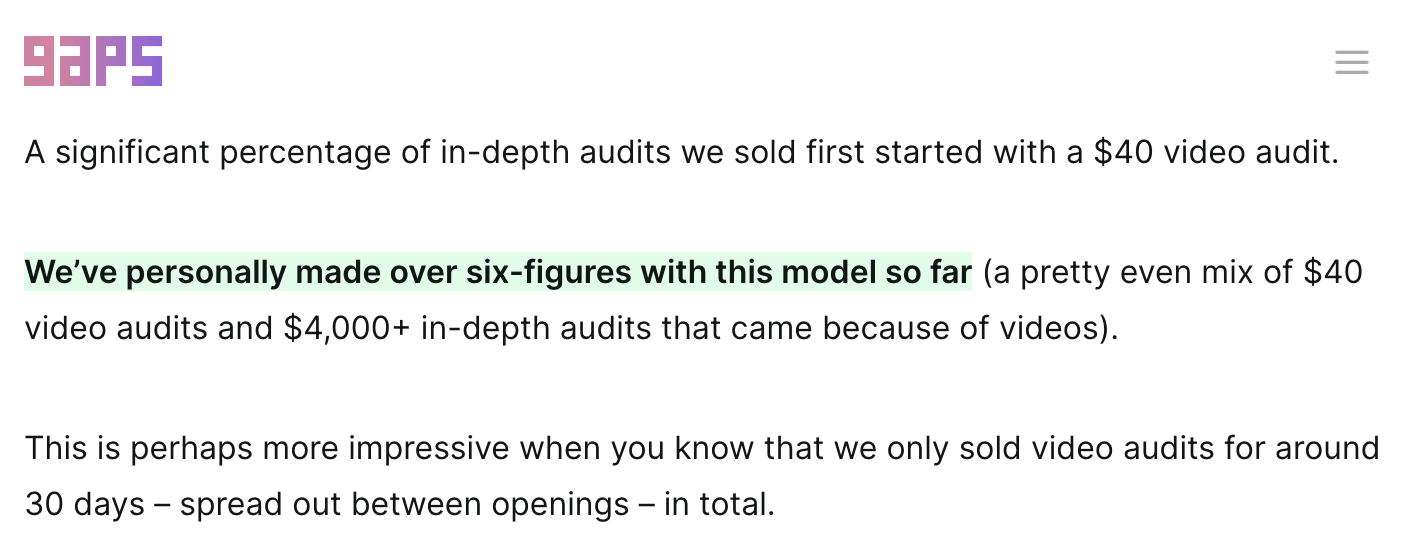
Another advantage of productized SEO services is that they can be sold on freelancer websites, where buyers search for specific SEO tasks rather than a fully managed SEO service.
Here’s an example of a productized service for Google My Business I found on a popular freelancing site.

As we can see from the description below, everyone gets the same format of audit, which means it should be relatively easy to scale.

So what are the most popular forms of productized SEO services you can sell?
SEO audits
It might not look like much, but this seller below has 1,000+ sales and charges £125 (~$155) per audit. This means that he has sold ~$155,000 worth of SEO audits.

SEOs have different methods for completing audits, but if you want to start providing them as a productized service, you should check out our SEO audit post first.
In that post, you can see that the core elements of an SEO audit have been broken down into different checks, which you can use as a basis for your audit.
They are:
- Check for manual actions
- Check organic traffic
- Check for HTTPS-related issues
- Check that you can only browse one version of your website
- Check for indexability issues
- Check for mobile-friendliness
- Check page speed
- Check Core Web Vitals
- Check for broken pages
- Check for sitemap issues
- Check basic on-page elements
- Check for declining content
- Check for content gaps
- Check for other technical issues
You may want to add further checks yourself, but this gives you a framework to start providing SEO audits as a productized service and start making money.
Keyword research
Another productized SEO service you can sell is keyword research. The basic process for creating a keyword research document is simple: You research the relevant metrics for a given keyword and then report them back to the client.
There is no shortage of SEOs on freelance sites who have made decent money by providing keyword research as a productized service.
We can see from the example below that if we multiply the sales by the product cost, the seller has made ~£12,000 from selling keyword research in this particular gig.

To start making money with keyword research as a productized service, you must focus on what website owners want.
They will most likely want to know the best keywords to target. You can provide this to them by identifying low-competition keywords.
Using Ahrefs’ Keywords Explorer, you can easily find 20 low-competition keywords and charge $XX for this.
Recommendation
Let’s look at how we can identify low-competition keywords related to “macbook air.”
First, go to Keywords Explorer and plug in the keyword “macbook air.” The overview will show the keyword’s difficulty, search volume, traffic potential, global volume, and even popular questions around the topic.

This information can help clients determine whether or not to target a particular keyword as part of their overall SEO strategy.
To identify low-competition keywords in this topic, we need to click on the Matching terms report and filter by KD from 0 to 25.
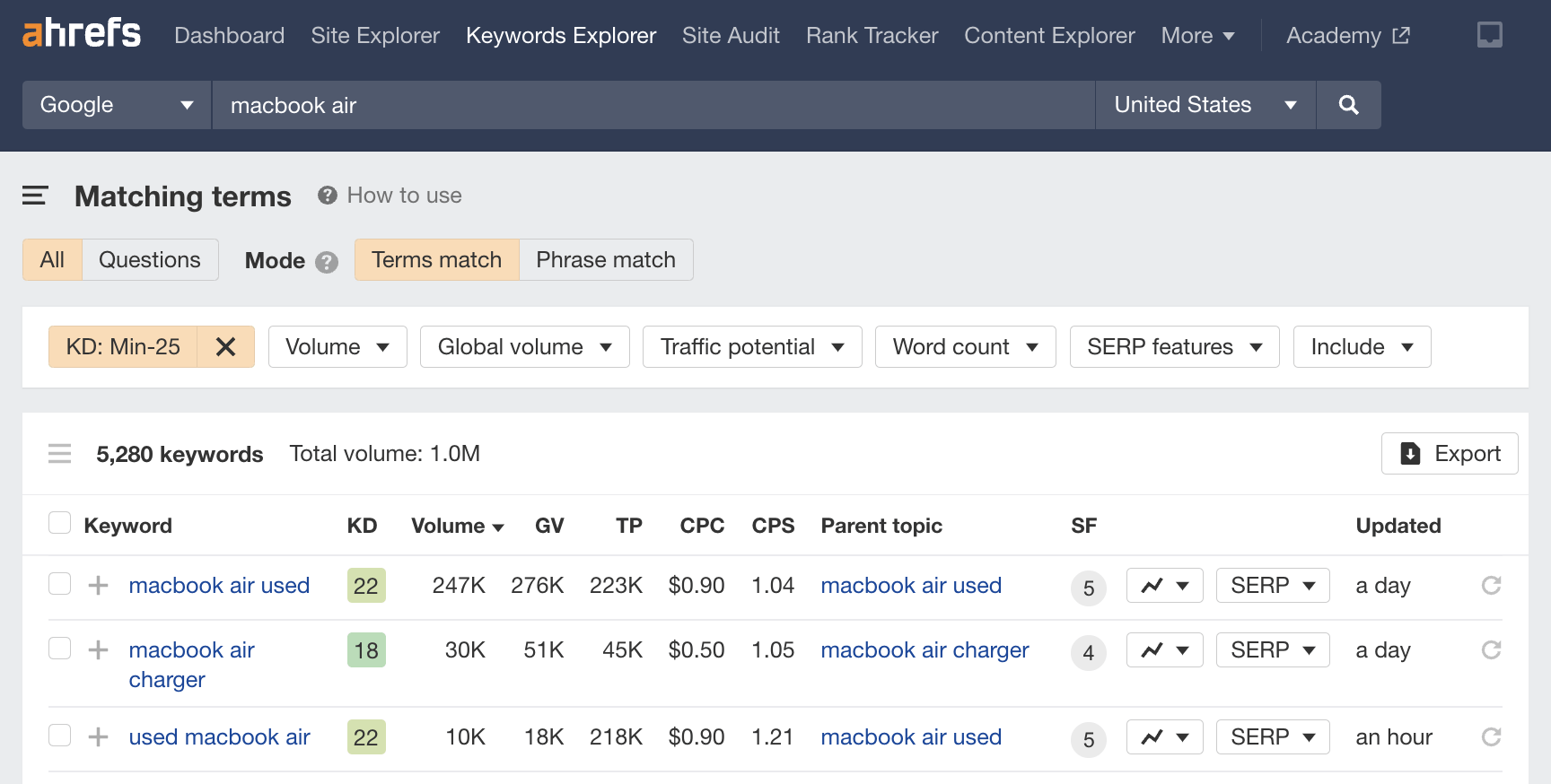
Once we have done this, we can see that the demand for used MacBook Air models is high—this alone may be an interesting insight you can share with your client.
Now we have a list of the lowest competition keywords to target for this keyword. To download this report, click the Export button in the top right-hand corner. Then review and format the data in your template before sending it to your client.
Link building
Links are still considered one of the most important Google ranking factors. If you can help acquire them for a client’s website through outreach or by creating content that attracts links naturally, this can be a valuable skill.
Returning to our freelance site, some charge £750 (~$927) for five DR 40 guest blogs via blogger outreach.

If we multiply the product price by the sales, we can see that this person has had 67 sales, meaning they have made ~$62,000.
When it comes to link building, it is not the most straightforward service to productize, but you can take the following approach:
- Create a service along the lines of: “I will land 10 guest post placements for $1,000 for your website.”
- Assuming you get a ~20% hit rate, it will mean that you will have to find and pitch 50 sites for this to work—quite achievable.
If you want to know the exact process of how to build links, the best way to do this is to check out our updated link building guide.
Sidenote.
You must know at least the SEO basics before attempting to sell productized SEO services. If you are knowledgeable about SEO and provide genuine value to your customers, you will stand a better chance of growing your business.
If you enjoy writing, creating content for websites may be one of the fastest ways to make money. There has always been a constant demand for high-quality content writers in SEO, and that trend looks set to continue based on the search volume trend below for the phrase “content creator.”

Out of all of the methods here, this one has the lowest barrier to entry. So long as you are a reasonably good writer, you can make six figures writing content.
Six figures may sound like a lot, but it is achievable. For example, Elise Dopson, a freelance content creator, managed to build a six-figure writing business from scratch, all by the age of 21.
So how can you find a content writing job and start making money?
To find content work, you have several different options:
You can search popular freelance sites, join a content agency, or even just check out popular Reddit threads such as /r/hireawriter, /r/forhire, and /r/freelance—where you can share your content writing services.
Recommendation
To show you how easy it can be, I set up a basic advert on a popular freelance site to “write an engaging 500-word article on any topic.” I didn’t include any information about qualifications or include a portfolio of my work.

After 177 views of my advert, I got an offer of work:

And then another…

Hopefully, this shows how straightforward it can be to start making money by writing content.
If you are new to SEO, you may wonder what a “niche site” is. This phrase is SEO jargon for “a blog about a particular topic.”
Here are two examples of niche sites that focus on a particular topic:
So how do you make money with a niche site?
The first thing is to build traffic to your site. Once you have some traffic, you can start to monetize it. One of the easiest ways to do this is using Amazon Associates, but it’s worth noting that the commissions have been fairly low in recent years.
The amount of money that you make with a niche site can vary from month to month. But it is clear that if you stick to it, the income can be significant in the long term.
Here are two examples from Flippa of sites making decent money from their respective niches.

Let’s take a look at a few niche site examples in more depth:
1. Coffee Detective

- The website offers common-sense tips, guides, and reviews to help you make coffee at home.
- If you can’t live without coffee, then you may find this an easy topic to write about.
- In terms of monetization, Coffee Detective is monetized by Mediavine and Amazon Associates.
Let’s use Ahrefs’ Site Explorer to get an idea of how much organic traffic it is getting and the value of that traffic.

- In the overview, coffeedetective.com is getting an estimated 17,700 organic monthly traffic and has an organic monthly traffic value of ~$11,100.
If we go to the Top pages report, we can see that ~18% of the traffic comes from just two articles.
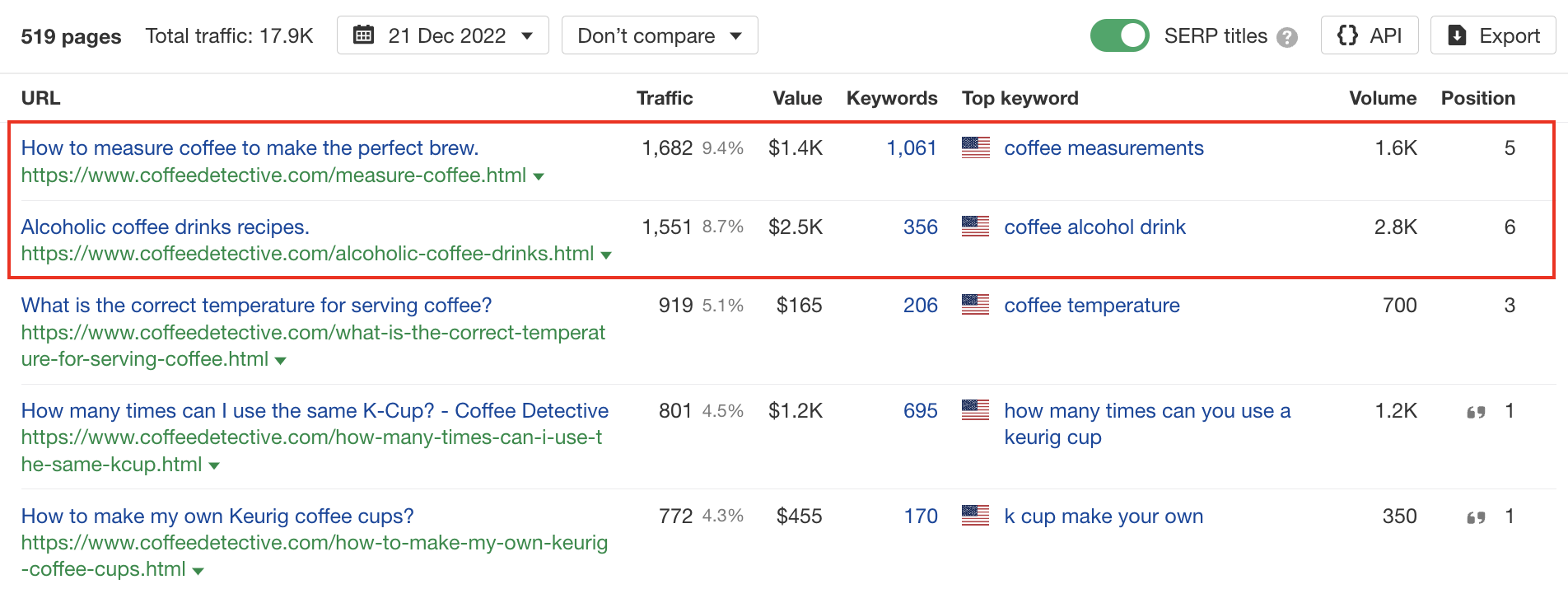
Using Ahrefs’ SEO Toolbar, we can see that the top page has fewer than 1,000 words of content—showing that you don’t always need thousands of words of content to rank well on Google and get traffic.
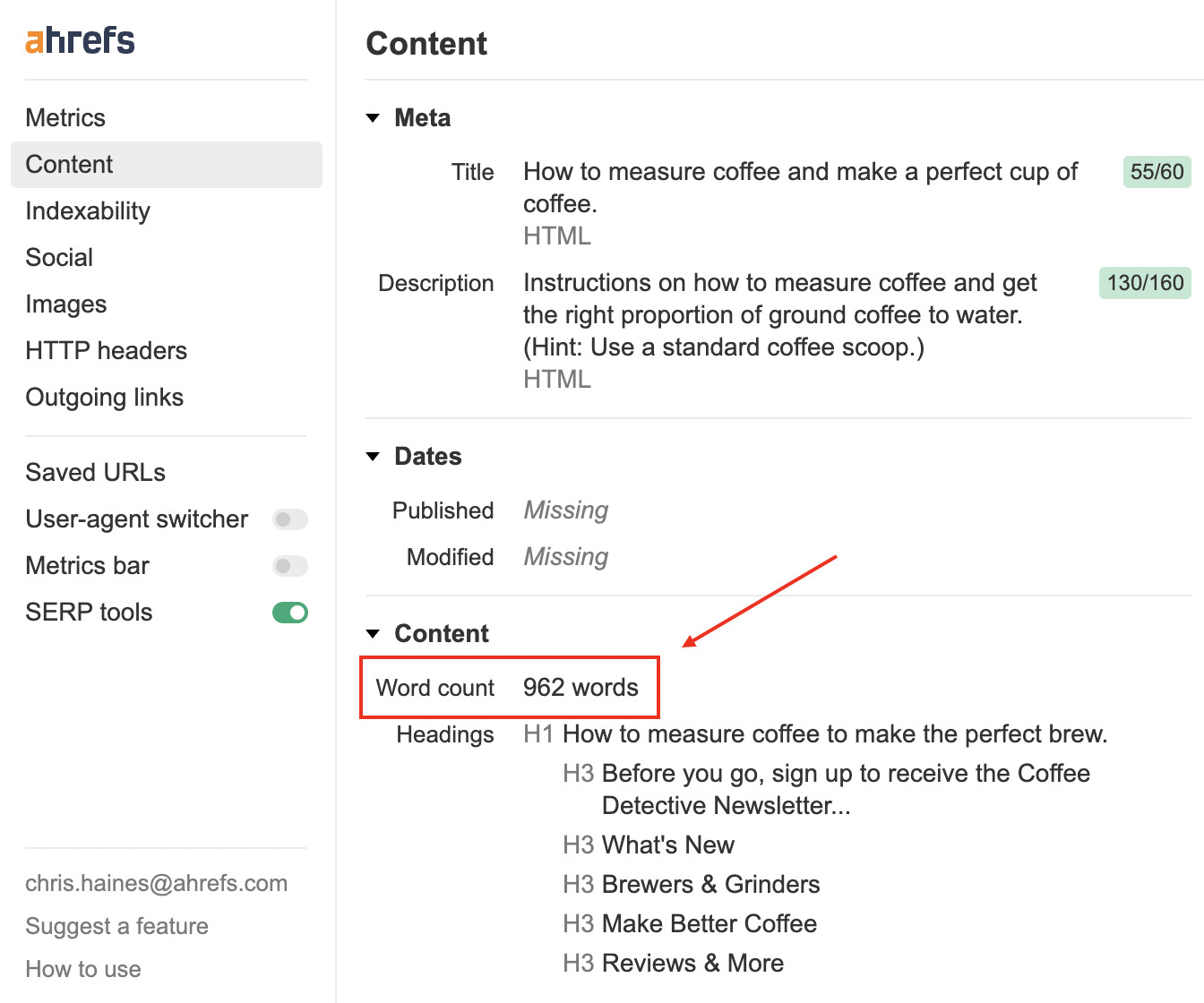
Let’s take a look at another example.
2. Get Busy Gardening

- This site has a variety of posts on a wide range of topics related to gardening, such as growing food, garden care, and gardening techniques.
- If you know a bit about gardening, this can be an excellent topic to write about.
- In terms of monetization, Get Busy Gardening is monetized with Mediavine and Amazon Associates.
In Ahrefs’ Site Explorer, let’s take a closer look at the estimated organic traffic and its value.

- We can see that getbusygardening.com is getting ~438,000 organic monthly traffic and has a value of ~$105,000.
Let’s go to the Top pages report. We can see that 5.1% of the site’s traffic comes from a single article.

These examples show that even a simple idea, such as making coffee at home or gardening tips, can provide a life-changing income.
However, if we look closer at both sites, they started being active around 2016. So it has taken them at least six years to build up to these organic traffic levels.
So while creating a niche site can be financially rewarding in the long term, it’s not the quickest way to make money with SEO.
Both e-commerce and dropshipping are well known for their six-figure case studies. A quick browse of Flippa shows us that many sites are changing hands for six figures or more.

Here’s an example of an e-commerce website, Code and Quill. According to Flippa, it has a monthly profit of $2,576/mo.

Here’s another example of a dropshipping site, Barbell Standard, which according to Flippa, has a monthly profit of $20,496/mo. This site is only two years old.
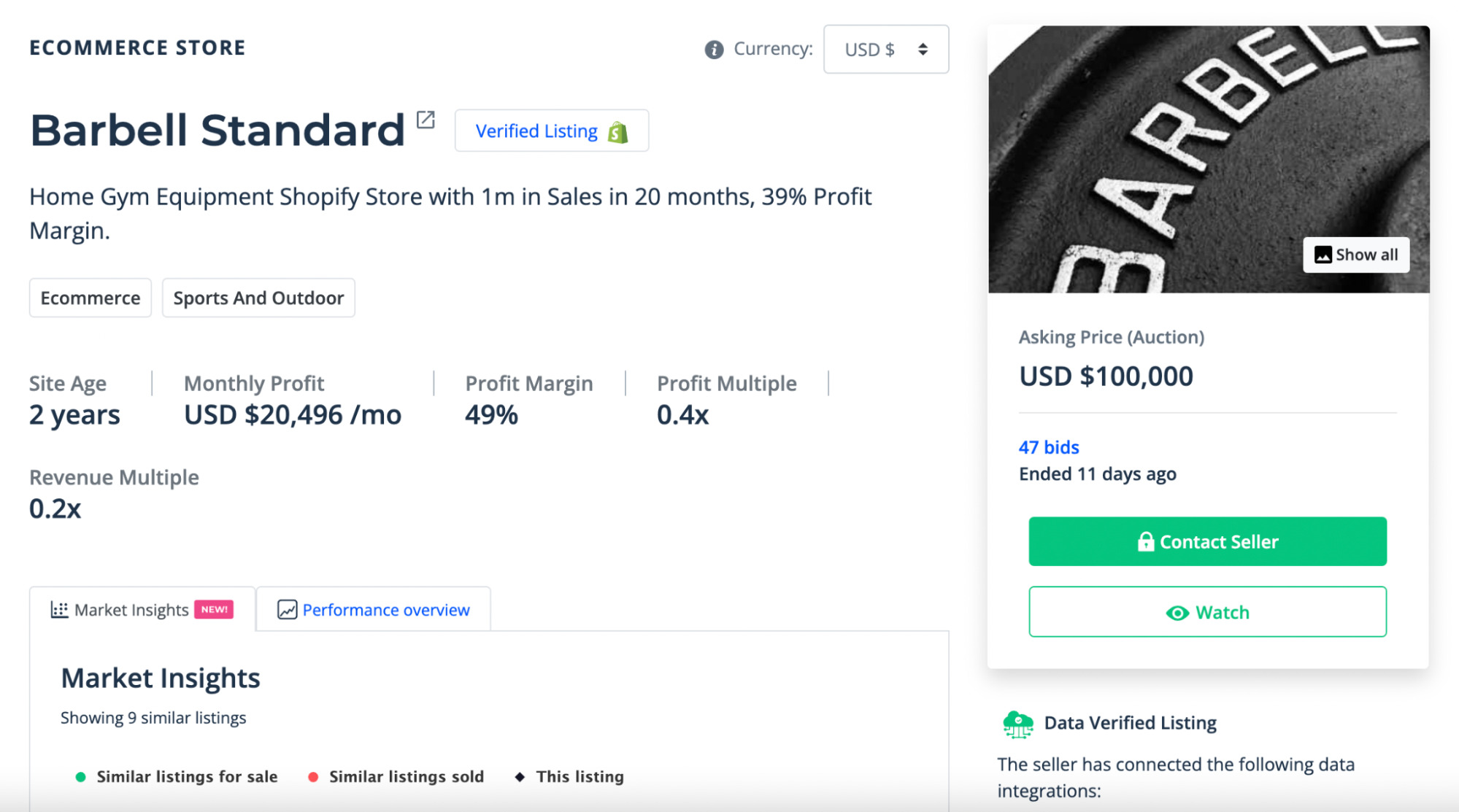
If you want to make money with e-commerce or dropshipping, you will first need to identify at least one product you can be reasonably sure will sell online.
In my opinion, the simplest way to do this is to:
- Find a site selling products in the category you are interested in.
- Plug it into Ahrefs’ Site Explorer.
- Check the Top pages report.
Check out the example below of me doing this.

Once I plugged a website into Ahrefs’ Keywords Explorer, the keyword “fidget toys” caught my attention.
Let’s click on “fidget toys” and go to the overview to take a closer look at this keyword.

A quick five-second check shows that this sharp peak occurred in April 2017 and again in May 2021. It’s clear from the trend graph that this is not a great product to create a store around at the moment.
Recommendation
It’s vital to sense-check your keywords because, sometimes, your perception of a keyword’s popularity may differ from the data.
In a different example, let’s say you wanted to set up an e-commerce site selling popular variations of hoodies. You can easily find all the variations of the most searched for hoodies using Ahrefs.
To do this, enter “hoodies” in the search bar of Keywords Explorer and click on the Matching terms report in the sidebar.
We can now see the most popular hoodie variations, allowing us to position our e-commerce store effectively.

The keyword “anime hoodies” sounds interesting—let’s take a closer look at this keyword by clicking on the link.

Once you have clicked the keyword, you should see the overview screen again. We can see that this keyword’s trend varies quite a lot, but it has been relatively positive over the last few years.
If you want to maximize your profits in e-commerce and dropshipping, you will need to consider the current trend of the product, its Keyword Difficulty, and Traffic Potential.
So what exactly is “website flipping?”
In simple terms, website flipping is the process of buying a website, improving it, and selling it for more money.
Website flipping can be particularly lucrative if you have a few years of experience working in SEO already.
For example, here’s a case study where a website was flipped for $136,000 in just 16 months.

Here are some key points to remember when flipping websites for money:
- When purchasing a website, you want to look for one with good links but where the content can be improved. You can use Ahrefs’ Site Explorer to help you decide on this.
- According to Flippa, returns for flipping websites can be more than 50X its average monthly earnings. In other words, if a website has average earnings over the last 12 months of $1,000 per month, it can be worth ~$50,000.
- Once you have a rough idea of how much the site is worth, you will need to choose a broker. Empire Flippers provides such a service and is one of the most trusted platforms where you can buy and sell websites.
Website flipping can be lucrative, but you must understand what to look for when purchasing a website. It also helps to have at least a basic knowledge of SEO.
Once you have gained several years of experience in SEO, you may feel that your skills are better used to help others learn the skills you have acquired.
Authority Hacker did just that to build a six-figure business.

You can do this as well by creating high-quality SEO courses for in-person or online coaching. You can sell these courses and training materials through your website, Gumroad, Udemy, Teachable, or any other platform.
To get set up selling your course, you will first need to decide what format it will be in.
Here are a few examples of ways you can sell your course in different formats:
- Provide free video lessons on YouTube and monetize with ads
- Provide premium video lessons on a paid platform (Udemy, Teachable)
- Create templates or instructions for specific tasks and sell on Gumroad, e.g., site speed optimization for WordPress
- Set up an expert online community and charge a monthly subscription fee
- Create a documented course and provide one-to-one training in person or remotely
If you have a background in teaching, this method could be an excellent way for you to make money.
It may not be the most exciting method to make money with SEO, but providing SEO consulting services is one of the most tried and tested approaches for making money—it’s how many SEOs make their living.
It’s challenging to verify the amount SEOs are making from consultation, but our survey suggests over 25% of respondents charged ~$101–150 per hour, with some charging ~$750 per hour.
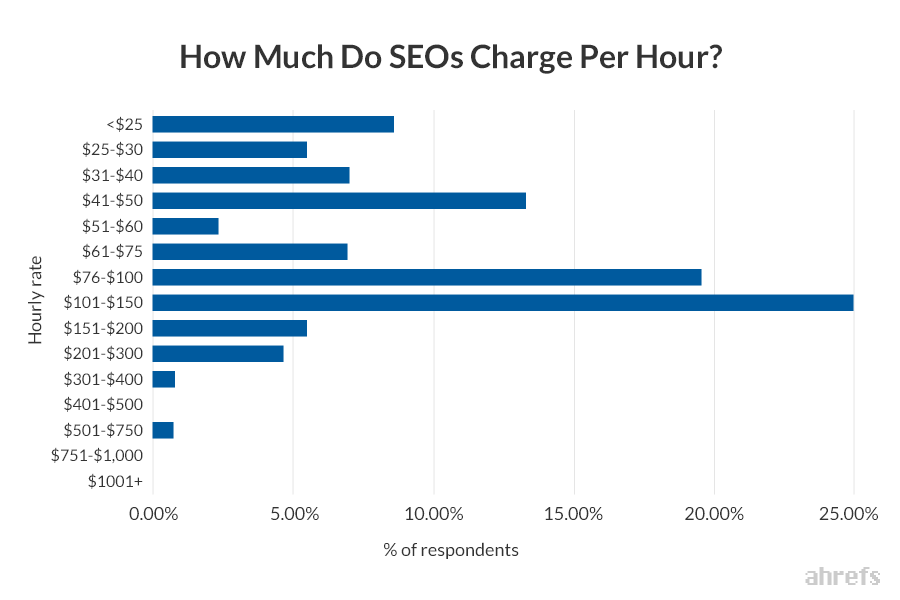
If you want to get started with SEO consulting, check out our how to get a job in SEO post. It will give you a good overview of what to expect when looking for SEO jobs and following a more traditional SEO career path. If you are determined, you can get to a senior role in just a few years.
Final thoughts
SEO can be extremely lucrative—but it does take time, effort, and a bucketload of determination to make the big bucks.
It’s worth remembering that the people making the most money in SEO are not always the most well-versed technical SEOs. Crucially, however, they know how to leverage their skills to make money.
Maybe you can too?
Got questions? Ping me on Twitter.
SEO
Google Further Postpones Third-Party Cookie Deprecation In Chrome

Google has again delayed its plan to phase out third-party cookies in the Chrome web browser. The latest postponement comes after ongoing challenges in reconciling feedback from industry stakeholders and regulators.
The announcement was made in Google and the UK’s Competition and Markets Authority (CMA) joint quarterly report on the Privacy Sandbox initiative, scheduled for release on April 26.
Chrome’s Third-Party Cookie Phaseout Pushed To 2025
Google states it “will not complete third-party cookie deprecation during the second half of Q4” this year as planned.
Instead, the tech giant aims to begin deprecating third-party cookies in Chrome “starting early next year,” assuming an agreement can be reached with the CMA and the UK’s Information Commissioner’s Office (ICO).
The statement reads:
“We recognize that there are ongoing challenges related to reconciling divergent feedback from the industry, regulators and developers, and will continue to engage closely with the entire ecosystem. It’s also critical that the CMA has sufficient time to review all evidence, including results from industry tests, which the CMA has asked market participants to provide by the end of June.”
Continued Engagement With Regulators
Google reiterated its commitment to “engaging closely with the CMA and ICO” throughout the process and hopes to conclude discussions this year.
This marks the third delay to Google’s plan to deprecate third-party cookies, initially aiming for a Q3 2023 phaseout before pushing it back to late 2024.
The postponements reflect the challenges in transitioning away from cross-site user tracking while balancing privacy and advertiser interests.
Transition Period & Impact
In January, Chrome began restricting third-party cookie access for 1% of users globally. This percentage was expected to gradually increase until 100% of users were covered by Q3 2024.
However, the latest delay gives websites and services more time to migrate away from third-party cookie dependencies through Google’s limited “deprecation trials” program.
The trials offer temporary cookie access extensions until December 27, 2024, for non-advertising use cases that can demonstrate direct user impact and functional breakage.
While easing the transition, the trials have strict eligibility rules. Advertising-related services are ineligible, and origins matching known ad-related domains are rejected.
Google states the program aims to address functional issues rather than relieve general data collection inconveniences.
Publisher & Advertiser Implications
The repeated delays highlight the potential disruption for digital publishers and advertisers relying on third-party cookie tracking.
Industry groups have raised concerns that restricting cross-site tracking could push websites toward more opaque privacy-invasive practices.
However, privacy advocates view the phaseout as crucial in preventing covert user profiling across the web.
With the latest postponement, all parties have more time to prepare for the eventual loss of third-party cookies and adopt Google’s proposed Privacy Sandbox APIs as replacements.
Featured Image: Novikov Aleksey/Shutterstock
SEO
How To Write ChatGPT Prompts To Get The Best Results

ChatGPT is a game changer in the field of SEO. This powerful language model can generate human-like content, making it an invaluable tool for SEO professionals.
However, the prompts you provide largely determine the quality of the output.
To unlock the full potential of ChatGPT and create content that resonates with your audience and search engines, writing effective prompts is crucial.
In this comprehensive guide, we’ll explore the art of writing prompts for ChatGPT, covering everything from basic techniques to advanced strategies for layering prompts and generating high-quality, SEO-friendly content.
Writing Prompts For ChatGPT
What Is A ChatGPT Prompt?
A ChatGPT prompt is an instruction or discussion topic a user provides for the ChatGPT AI model to respond to.
The prompt can be a question, statement, or any other stimulus to spark creativity, reflection, or engagement.
Users can use the prompt to generate ideas, share their thoughts, or start a conversation.
ChatGPT prompts are designed to be open-ended and can be customized based on the user’s preferences and interests.
How To Write Prompts For ChatGPT
Start by giving ChatGPT a writing prompt, such as, “Write a short story about a person who discovers they have a superpower.”
ChatGPT will then generate a response based on your prompt. Depending on the prompt’s complexity and the level of detail you requested, the answer may be a few sentences or several paragraphs long.
Use the ChatGPT-generated response as a starting point for your writing. You can take the ideas and concepts presented in the answer and expand upon them, adding your own unique spin to the story.
If you want to generate additional ideas, try asking ChatGPT follow-up questions related to your original prompt.
For example, you could ask, “What challenges might the person face in exploring their newfound superpower?” Or, “How might the person’s relationships with others be affected by their superpower?”
Remember that ChatGPT’s answers are generated by artificial intelligence and may not always be perfect or exactly what you want.
However, they can still be a great source of inspiration and help you start writing.
Must-Have GPTs Assistant
I recommend installing the WebBrowser Assistant created by the OpenAI Team. This tool allows you to add relevant Bing results to your ChatGPT prompts.
This assistant adds the first web results to your ChatGPT prompts for more accurate and up-to-date conversations.
It is very easy to install in only two clicks. (Click on Start Chat.)
For example, if I ask, “Who is Vincent Terrasi?,” ChatGPT has no answer.
With WebBrower Assistant, the assistant creates a new prompt with the first Bing results, and now ChatGPT knows who Vincent Terrasi is.
 Screenshot from ChatGPT, March 2023
Screenshot from ChatGPT, March 2023You can test other GPT assistants available in the GPTs search engine if you want to use Google results.
Master Reverse Prompt Engineering
ChatGPT can be an excellent tool for reverse engineering prompts because it generates natural and engaging responses to any given input.
By analyzing the prompts generated by ChatGPT, it is possible to gain insight into the model’s underlying thought processes and decision-making strategies.
One key benefit of using ChatGPT to reverse engineer prompts is that the model is highly transparent in its decision-making.
This means that the reasoning and logic behind each response can be traced, making it easier to understand how the model arrives at its conclusions.
Once you’ve done this a few times for different types of content, you’ll gain insight into crafting more effective prompts.
Prepare Your ChatGPT For Generating Prompts
First, activate the reverse prompt engineering.
- Type the following prompt: “Enable Reverse Prompt Engineering? By Reverse Prompt Engineering I mean creating a prompt from a given text.”
 Screenshot from ChatGPT, March 2023
Screenshot from ChatGPT, March 2023ChatGPT is now ready to generate your prompt. You can test the product description in a new chatbot session and evaluate the generated prompt.
- Type: “Create a very technical reverse prompt engineering template for a product description about iPhone 11.”
 Screenshot from ChatGPT, March 2023
Screenshot from ChatGPT, March 2023The result is amazing. You can test with a full text that you want to reproduce. Here is an example of a prompt for selling a Kindle on Amazon.
- Type: “Reverse Prompt engineer the following {product), capture the writing style and the length of the text :
product =”
 Screenshot from ChatGPT, March 2023
Screenshot from ChatGPT, March 2023I tested it on an SEJ blog post. Enjoy the analysis – it is excellent.
- Type: “Reverse Prompt engineer the following {text}, capture the tone and writing style of the {text} to include in the prompt :
text = all text coming from https://www.searchenginejournal.com/google-bard-training-data/478941/”
 Screenshot from ChatGPT, March 2023
Screenshot from ChatGPT, March 2023But be careful not to use ChatGPT to generate your texts. It is just a personal assistant.
Go Deeper
Prompts and examples for SEO:
- Keyword research and content ideas prompt: “Provide a list of 20 long-tail keyword ideas related to ‘local SEO strategies’ along with brief content topic descriptions for each keyword.”
- Optimizing content for featured snippets prompt: “Write a 40-50 word paragraph optimized for the query ‘what is the featured snippet in Google search’ that could potentially earn the featured snippet.”
- Creating meta descriptions prompt: “Draft a compelling meta description for the following blog post title: ’10 Technical SEO Factors You Can’t Ignore in 2024′.”
Important Considerations:
- Always Fact-Check: While ChatGPT can be a helpful tool, it’s crucial to remember that it may generate inaccurate or fabricated information. Always verify any facts, statistics, or quotes generated by ChatGPT before incorporating them into your content.
- Maintain Control and Creativity: Use ChatGPT as a tool to assist your writing, not replace it. Don’t rely on it to do your thinking or create content from scratch. Your unique perspective and creativity are essential for producing high-quality, engaging content.
- Iteration is Key: Refine and revise the outputs generated by ChatGPT to ensure they align with your voice, style, and intended message.
Additional Prompts for Rewording and SEO:
– Rewrite this sentence to be more concise and impactful.
– Suggest alternative phrasing for this section to improve clarity.
– Identify opportunities to incorporate relevant internal and external links.
– Analyze the keyword density and suggest improvements for better SEO.
Remember, while ChatGPT can be a valuable tool, it’s essential to use it responsibly and maintain control over your content creation process.
Experiment And Refine Your Prompting Techniques
Writing effective prompts for ChatGPT is an essential skill for any SEO professional who wants to harness the power of AI-generated content.
Hopefully, the insights and examples shared in this article can inspire you and help guide you to crafting stronger prompts that yield high-quality content.
Remember to experiment with layering prompts, iterating on the output, and continually refining your prompting techniques.
This will help you stay ahead of the curve in the ever-changing world of SEO.
More resources:
Featured Image: Tapati Rinchumrus/Shutterstock
SEO
Measuring Content Impact Across The Customer Journey

Understanding the impact of your content at every touchpoint of the customer journey is essential – but that’s easier said than done. From attracting potential leads to nurturing them into loyal customers, there are many touchpoints to look into.
So how do you identify and take advantage of these opportunities for growth?
Watch this on-demand webinar and learn a comprehensive approach for measuring the value of your content initiatives, so you can optimize resource allocation for maximum impact.
You’ll learn:
- Fresh methods for measuring your content’s impact.
- Fascinating insights using first-touch attribution, and how it differs from the usual last-touch perspective.
- Ways to persuade decision-makers to invest in more content by showcasing its value convincingly.
With Bill Franklin and Oliver Tani of DAC Group, we unravel the nuances of attribution modeling, emphasizing the significance of layering first-touch and last-touch attribution within your measurement strategy.
Check out these insights to help you craft compelling content tailored to each stage, using an approach rooted in first-hand experience to ensure your content resonates.
Whether you’re a seasoned marketer or new to content measurement, this webinar promises valuable insights and actionable tactics to elevate your SEO game and optimize your content initiatives for success.
View the slides below or check out the full webinar for all the details.
-

 PPC6 days ago
PPC6 days ago19 Best SEO Tools in 2024 (For Every Use Case)
-
SEARCHENGINES5 days ago
Daily Search Forum Recap: April 19, 2024
-

 MARKETING7 days ago
MARKETING7 days agoEcommerce evolution: Blurring the lines between B2B and B2C
-
SEARCHENGINES6 days ago
Daily Search Forum Recap: April 18, 2024
-

 WORDPRESS6 days ago
WORDPRESS6 days agoHow to Make $5000 of Passive Income Every Month in WordPress
-

 SEO7 days ago
SEO7 days ago2024 WordPress Vulnerability Report Shows Errors Sites Keep Making
-

 WORDPRESS6 days ago
WORDPRESS6 days ago10 Amazing WordPress Design Resouces – WordPress.com News
-
WORDPRESS7 days ago
[GET] The7 Website And Ecommerce Builder For WordPress
















You must be logged in to post a comment Login